House Finch: Field Guide, Pictures, Habitat & Info
Last Updated on
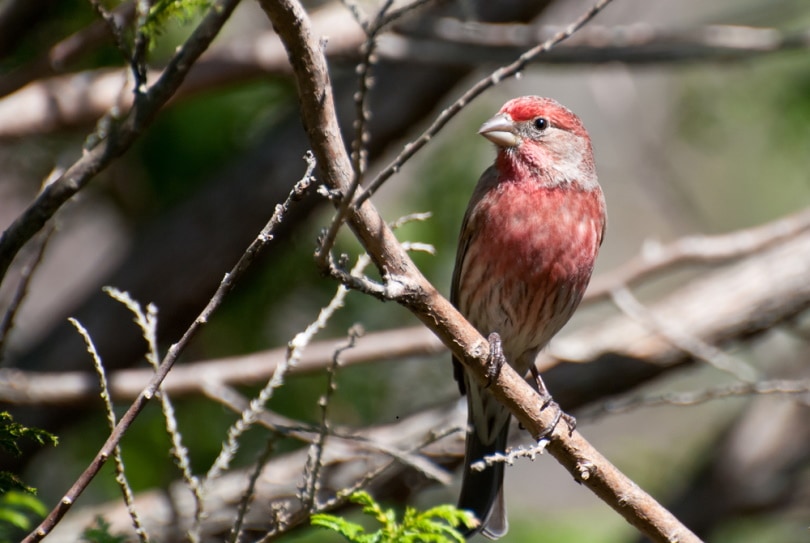
House Finches are a popular and commonly spotted bird throughout much of North America. They are especially fond of cities, towns, and suburbs where they can regularly be seen eating from feeders and bathing in birdbaths. They are an abundant species and feed primarily on plant-based foods, although they will take in a small number of insects.
The male is recognized by its colored belly, head, and neck, while the female tends to consist of shades of brown. The color of the male’s plumage is determined by the bird’s diet and can vary from yellow to red.

Quick Facts About House Finches
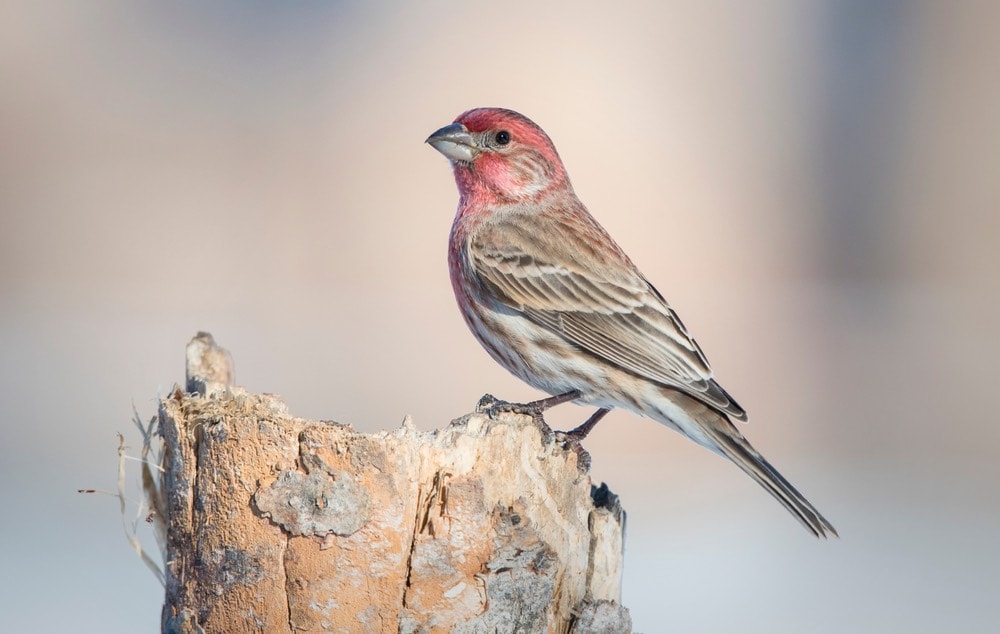
| Habitat | Buildings, lawns, towns |
| Diet | Weeds, seeds, berries, some Insects |
| Behavior | Not territorial, may flock together |
| Nesting | Nest in trees and rock ledges |
| Conservation | Least concern |
| Scientific name | Haemorhous mexicanus |
| Lifespan: | 10–12 years |
House Finch General Description
The House Finch is a small finch with a flat head and larger beak. They will grow to approximately 5 inches and weigh less than an ounce. Their wingspan is around 9 inches. The House Finch has short wings and a long tail.
Immature birds and females are brown, ranging from light brown to almost black. Males have a brown back and colored belly, neck, and head. The color does vary according to the bird’s diet, with a carotenoid-rich diet typically leading to red plumage. Other males can have yellow plumage.
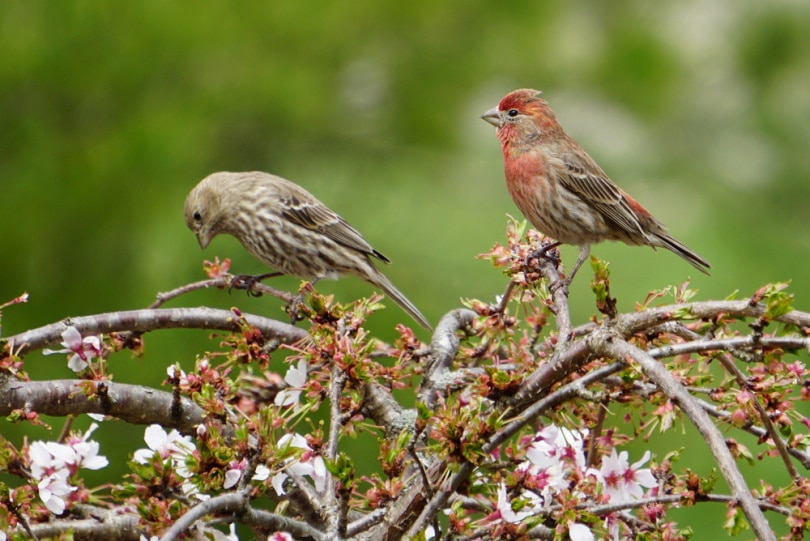
House Finch Range, Habitat, Behavior, Diet & Nesting
The House Finch has become prevalent across the US over the past 70 years. In the east, it competes with the Purple Finch, for which it can be easily confused, for food and habitat.
Range
The House Finch originates from the southwest, but it has spread right across North America, especially in the 1940s. At this time, New York pet shop owners who had been selling the birds illegally were forced to set their birds free to avoid being caught and prosecuted. The birds settled in New York’s suburbs and, as numbers have increased, so too has their habitat.
Habitat
In its original habitat, the House Finch enjoys open plains, deserts, and other open areas of land. However, it has adapted according to the region it inhabits. In the east, it lives in and very close to urban areas and is especially fond of feeders and feeding stations as a source of food. Some finches from the north do migrate further south for winter, but this isn’t true of all of them, and they are often seen year-round at feeders.
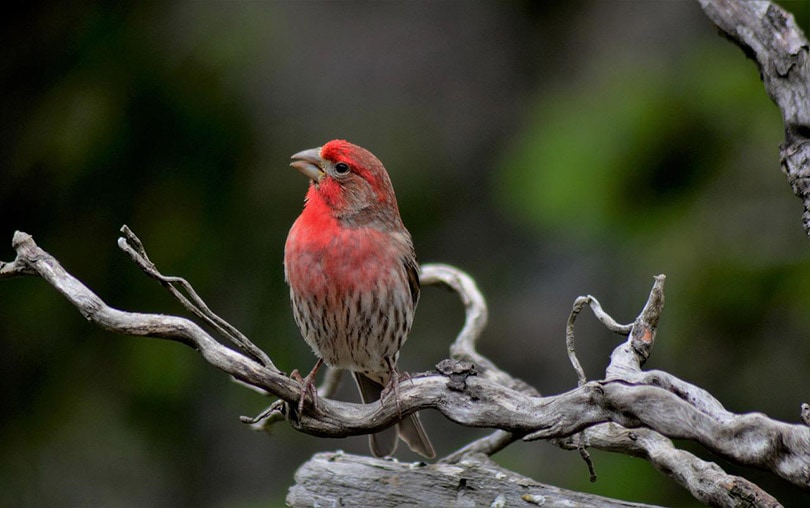
Behavior
The House Finch is not an especially aggressive or territorial bird and spotters frequently see flocks of the species together. The female tends to be dominant over the male and all are more active during the day than at night.
Diet
The majority of the House Finch’s diet is plant and vegetable based. They eat weed seeds as well as the buds and flowers of plants. They also eat some berries and a small number of insects.
Nesting
During the breeding season, the male performs a flight and song display and feeds the female during courtship. They will nest in trees, primarily conifers, but may also be found in ivy, cactus, and in buildings. They can be attracted to homemade bird boxes, and they prefer a nesting site about 12 feet off the ground.

How to Find House Finches: Birdwatching Tips
With the species prevalent across much of the country and happy to spend time in urban and suburban areas, it is popular with amateur and experienced spotters.
What to Listen For
Males are more likely to sing, although females will sing in the spring, too. Both have a long song that is made up of a series of short notes. It will usually last 2–3 seconds and end on a high or low note.
What to Look For
The House Finch is approximately the same size as a sparrow. They have small heads and large beaks. Their short wings can make their tails appear longer. The female is a somewhat plain brown while the male has a brown back and wings with either a yellow or red belly, neck, and head. Young House Finches have the same markings as adult females but are smaller.
When to Look
In most cases, House Finches can be seen all year round, although some of the northern populations do migrate south during the winter. They are active during the day rather than at night, so there is a good chance that a keen-eyed spotter will see at least one of these birds.
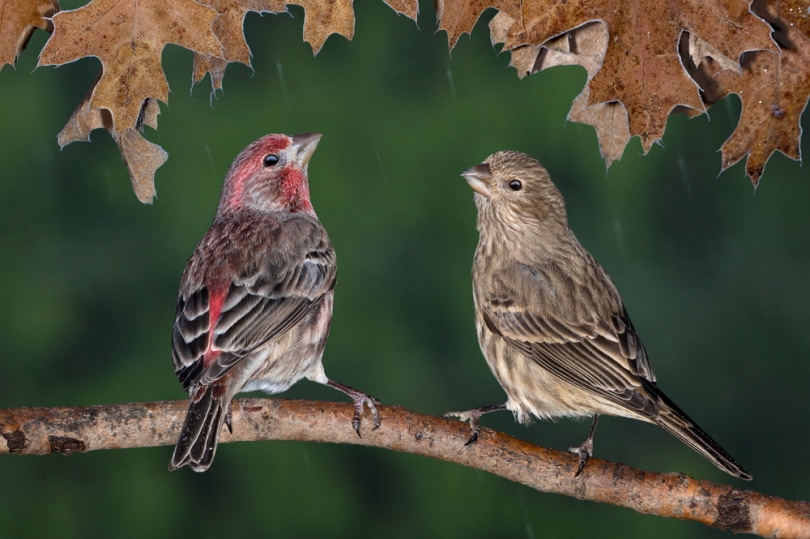
Attracting House Finches to Your Backyard: Tips & Tricks
The House Finch is a sweet and attractive little bird that can be very easy to attract to an outdoor feeder. Try these tips to increase the chances of a visit to your yard.
- Feeders: House Finches are foragers, which means that they prefer to gather their food up from the ground. However, they do also appreciate hollow pipe feeders. Ensure the tube has perches so that the birds can easily sit, gather, and eat the food.
- Feeder Location: The safer the House Finch feels, the more likely it will sit at a feeder and the longer it will stay. Ensure that the feeder is away from trees and bushes that cats and other predators can hide in and far enough off the ground that it won’t be bothered by animals.
- Add a Birdbath: Adding a birdbath will not only help attract House Finches but it means that you will be able to watch them wash and play in the water.
- Food: You can feed a birdseed mix, but do ensure that it contains black oil sunflower seeds because these are a particular favorite of the breed.
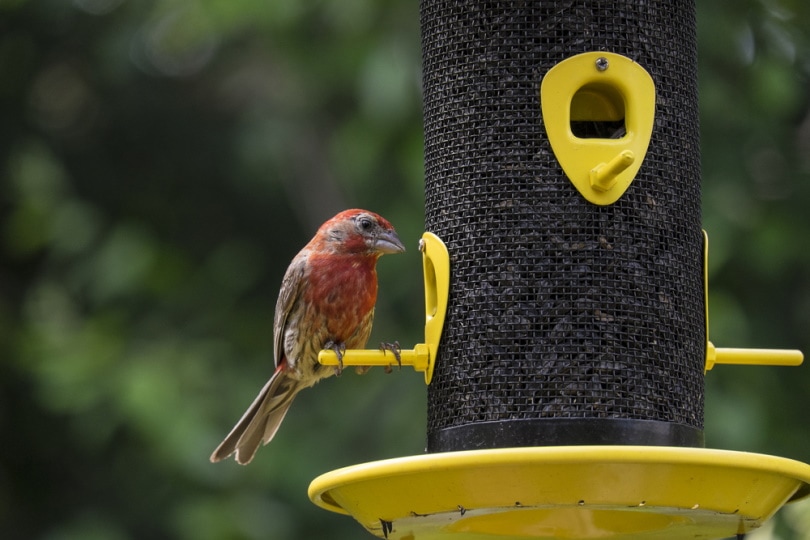
House Finch Conservation: Is This Bird Threatened?
The House Finch is classified as of least concern, which means that there are no current concerns over its population. In fact, the species has spread across the country and in some areas, primarily the east, it is threatening the Purple Finch’s population. The reason it does not seem to be under threat is that it will live alongside people in urban and suburban areas.

Conclusion
The House Finch is a small finch that can be found throughout North America. It is not under conservation threat and is actually considered something of a threat to other species in some areas. However, it is an attractive bird, especially the male’s red or yellow plumage, and it is easy to attract to a garden feeder, making it popular with novice bird watchers. If you want to attract the House Finch, add a safe tube feeder, fill it with black oil sunflower seeds, and accompany it with a birdbath.
Featured Image Credit: rck_953, Shutterstock
About the Author Robert Sparks
Robert’s obsession with all things optical started early in life, when his optician father would bring home prototypes for Robert to play with. Nowadays, Robert is dedicated to helping others find the right optics for their needs. His hobbies include astronomy, astrophysics, and model building. Originally from Newark, NJ, he resides in Santa Fe, New Mexico, where the nighttime skies are filled with glittering stars.
Related Articles:
10 Types of Hummingbirds in Arkansas (With Pictures)
8 Types of Hummingbirds in Nebraska (With Pictures)
5 Types of Hummingbirds in Idaho (With Pictures)
3 Types of Hummingbirds in Mississippi (With Pictures)
8 Types of Hummingbirds in Kansas (With Pictures)
5 Types of Hummingbirds in West Virginia (With Pictures)
5 Types of Hummingbirds in Ohio (With Pictures)
Where Do Nuthatches Nest? Nuthatch Nesting Habits Explained
